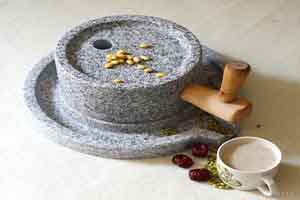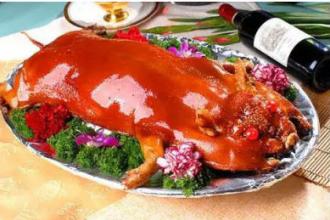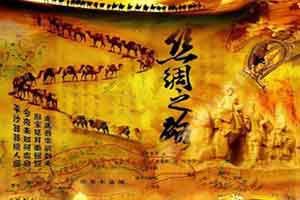History of China Food
Chinese food culture has a long history. Chinese traditional food culture is not only an important part of traditional Chinese culture but also a branch of traditional culture with unique characteristics. Ever since the beginning of Beijing ape-man using fire to barbecue food more than 50 million years ago, Chinese people began the evolution of food culture history.
Popularity of stone mill

From the Neolithic Age until the Shang dynasty, the processing of grain has been relatively simple. Ancestors perform coarse grain processing through rolling plates, rolling rods, and pestles and it was difficult to get a large amount of clean rice without shells inside. In the Zhou Dynasty, the emergence of the stone mill was a great leap in the initial processing of grains. The initial processing of grain has changed from rolling and mashing to mainly grinding. With the popularity of stone mill, Zhou people's diets have been greatly improved.
Beginning of meat processing

Compared with grain processing, Zhou's meat processing was more elegant. Moreover, the initial cut and picking of meat have the same importance as cooking later in history. The selection and cooking of various meat used by Zhou's royal family and nobles during sacrifice and banquets are done especially by the special government offices "Neiyong" and "Waiyong". Zhou's people have fully understood how to choose strong livestock without diseases and bad smell and to identify the various parts of poultry, and then slaughter. When eating, various dishes have its own fixed position and the order of eating certain dishes was also according to certain procedures, all of which were determined by the cutting shape of the meat.
Appearance of Eight Specials

The appearance of "Eight Specials" in the Zhou dynasty marks the culmination of cooking as an important art and demonstrates the Zhou people's consummate skill and scientific nature of their diet. Using roast pig as an example, the pig was first washed clean, belly stuffed with dates, wrapped with wet mud, roasted and then the mud was stripped to remove the pig. Second, pig's whole body was coated with rice flour paste, fried thoroughly and then cut into slices. Last, the seasoning was prepared, placed the meat on a small tripod. Then, the small tripod was put on a large tripod, and was continuously stewed for three days and three nights with slow fire. After all the cooking was done, the meat was then eaten with sauces and vinegar seasoning. This dish used three cooking methods: roast, fried, stewed, but the process used as many as dozens of steps. "Eight Specials" sets a precedent of creating dishes with multiple cooking methods and all of the following dazzling variety of dishes are developed on this basis and even inherited the name "Eight Specials" in their names, such as "The Eight Specials cake", "The Eight Specials noodle", and "The Eight Specials congee".
Birth of Four Major Cuisine

During Spring and Autumn Period, various ethnic groups integrated together and the two major north and south flavors gradually formed in Chinese food culture. In the north, the ancient Qilu food culture has a long history, advanced cooking techniques, and forms China's earliest local flavor dishes - the embryonic form of Shandong cuisine.
In the south, Chu united the southeast half of the country and created today's "land of the plenty." "Spring has bigmouth grenadier anchovy, summer has reeves shad, autumn has fat duck, winter has vegetables." Throughout the year, there were continuous supplies of aquatic livestock, poultry, and vegetables. This provided excellent conditions for the development of cooking techniques. As a result of the integration of many southern ethnic customs, folk customs, and eating habits, it gradually formed the embryonic form of today's Su cuisine.
In the west, Qin occupied the ancient Ba and Shu states, and then sent Li Bing to turn the land of flooding into a "land of abundance". With the arrival of a large number of immigrants from the Hanzhong region, combined with the local climate, customs, and ancient Ba and Shu traditional diet, the predecessor of the Sichuan cuisine, which has a huge influence on Chinese food culture today, was created.
At the end of Qin's reunification war, the Qin empire sent troops to occupy the Guilin, Nanhai and Xiang areas and established the Nanyue state. By taking advantage of Guangzhou's location nearby the southeastern coast, the Pearl River Delta's mild climate, rich products, wide variety of edible plants and animals, water, and land transportation's convenience, Lingnan's political, economic and cultural center was established. The current food culture in Guangdong, in fact, rooted in Zhao Tuo, introducing the central plain area's advanced cooking art and equipment to the Lingnan area, combined with local dietary resources, so that all "flying, swimming, animal, plant" became good food. This spreads until today and forms eclectic eating habits, which results in the creation of the Cantonese cuisine.
At this point, the embryonic form of the so-called "four major cuisines" of Shandong cuisine (including Beijing, Tianjin and other northern areas of dishes), Su cuisine (including Jiangsu, Zhejiang and Anhui flavors), Cantonese cuisine (including Fujian and Taiwan flavors), and Sichuan cuisine (including Hunan, Hubei, Guizhou, and Yunnan flavors) have been established.
Eating in Han and Tang Dynasty

After the completion of China's unification, the emperor of the Han Dynasty had the most complete food management system at the time. Among the officials responsible for the daily affairs of the emperors, there were officials in charge of the dietary, such as Tai, Tang, and Dao officials. They were responsible for meals, dumplings, and rice. There was a huge system of officials. The expenditure of emperor meal is equivalent to a property value of twenty thousand Han Dynasty middle-class families.
During this period, the spread of Chinese food culture exacerbated. Zhang Qian, a Chinese official and other people not only introduced cucumbers, walnuts, coriander, flax, carrots, pomegranates from Western Regions but also spread the Central Plains' peach, plum, apricot, pears, ginger, tea and other products and food cultural to the Western Regions. Today, among the original Western Regions unearthed cultural relics, there are wooden chopsticks from the Central Plains. There is a special cooking method in China's traditional barbecue techniques, which was introduced to Central Asia and West Asia through the Silk Road and ultimately became the well-known kebabs.
